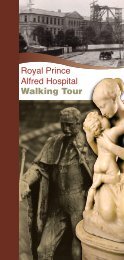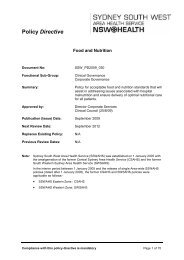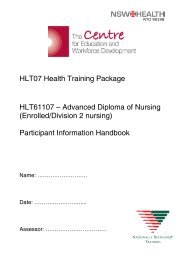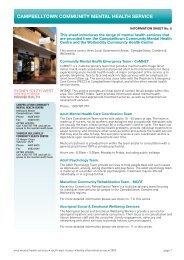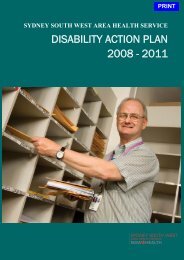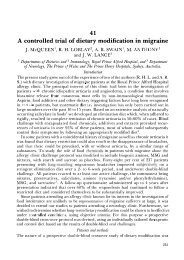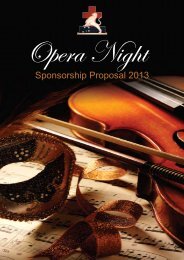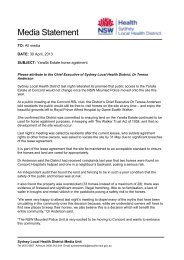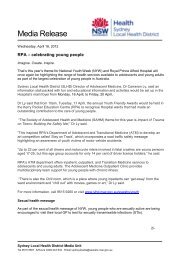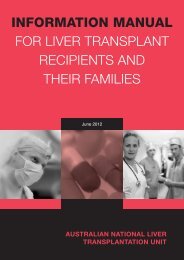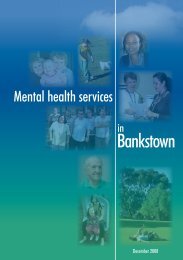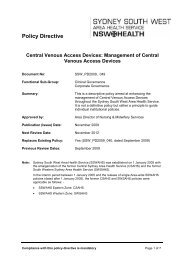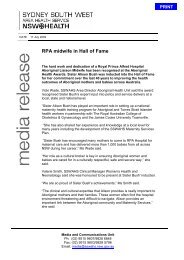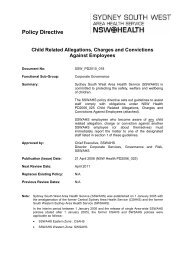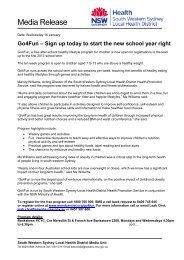Aged Care & Rehabilitation Clinical Services Plan 2007 – 2012
Aged Care & Rehabilitation Clinical Services Plan 2007 – 2012
Aged Care & Rehabilitation Clinical Services Plan 2007 – 2012
Create successful ePaper yourself
Turn your PDF publications into a flip-book with our unique Google optimized e-Paper software.
<strong>Aged</strong> <strong>Care</strong> & <strong>Rehabilitation</strong> <strong>Clinical</strong> Service <strong>Plan</strong> <strong>2007</strong> - <strong>2012</strong>Given the heavy reliance of AC&RS clients on carers, carer support is an essential component of theservice mix available to support the target group. Regardless of governance arrangements, strongrelationships are required between clinical services and the carer support services. These servicesare building cooperative links to strengthen their capacity to reach all carers across the Area and areimplementing a range of initiatives. Opportunities to enhance carer support services are consideredwithin the NSW <strong>Care</strong>rs Action <strong>Plan</strong> (NSW Department of Health, <strong>2007</strong>) and will be further exploredin the SSWAHS <strong>Care</strong>rs Action <strong>Plan</strong> to be developed by 2008.Recommendation – <strong>Care</strong>r Support <strong>Services</strong>Improve and expand carer support services, consistent with the NSW <strong>Care</strong>rs Action <strong>Plan</strong>8.10 Ventilator Dependant Quadriplegia Program including Children’s Home VentilationProgramThe NSW Ventilator Dependant Quadriplegic (VDQ) and Children’s Home Ventilation Program(CHVP) Program was established with a principle aim to assist Area Health <strong>Services</strong> with the costsassociated with the discharge of these clients from the acute inpatient facility. The program alsoallows clients to live with or close to family and friends, and to avoid inappropriate, long-termhospitalisation. Costs include establishing the client in the home, equipment and ongoingcommunity-based clinical care.The program’s target group includes 24-hour mechanical ventilation dependant quadriplegics whohave a brain stem or spinal cord injury, are either non-compensable or who have been inadequatelycompensated and are medically stable, and willing to be discharged to the community.In early <strong>2007</strong>, the state-wide program supported 17 clients in NSW, including two clients inSSWAHS. By late <strong>2007</strong>, an increasing number of children entered the Program in SSWAHS. If anon-traumatic spinal cord injury unit is developed in SSWAHS (see Section 8.3) then there may begrowth in demand for this service.The VDQ and CHVP Program is managed by AC&RS but given the growing number of childrenreferred to SSWAHS, it may be more suitable for management by another clinical stream.Recommendation – Ventilator Dependent Quadriplegia and Children’s Home Ventilation ProgramReview management arrangements of this Program within SSWAHS8.11 General PractitionersGeneral Practitioners (GPs) are an essential element in the care of older people in the communityand in residential care. The majority of GPs are members of a local Division of General Practice.Divisions of General Practice in SSWAHS include Central Sydney, Bankstown, Fairfield, Liverpool,Macarthur and Southern Highlands Divisions. Mergers of divisions commenced in <strong>2007</strong>.In 2005, there were 1,210 GPs who were a member of a Division. The total number of GPs in SSWAHSis however greater. The following table summarises the numbers of GPs (members and non-members)in each Divisional area in 2005. Non-members numbers are an approximation as they are difficult toaccurately estimate due to the constant movement of the GP workforce. It should also be noted that asmall percentage of members may not actively practice in the area.Area populations have been provided to give an idea of the population the GPs service, however anaccurate GP:population ratio cannot be determined from GP numbers alone. These GPs work arange of hours, from 10 to 60+ hours per week. Therefore the full-time equivalent (FTE) workforce isactually less than the numbers shown. Table 8.1 shows a FTE GP:population ratio estimate.SSWAHS has ethnically diverse populations. Many GPs working in these areas speak one or morelanguages other than English. Approximate numbers of bi-lingual GPs are shown below. The mostcommon languages spoken are Chinese, Arabic, Vietnamese, Spanish and Hindi.Page 67



